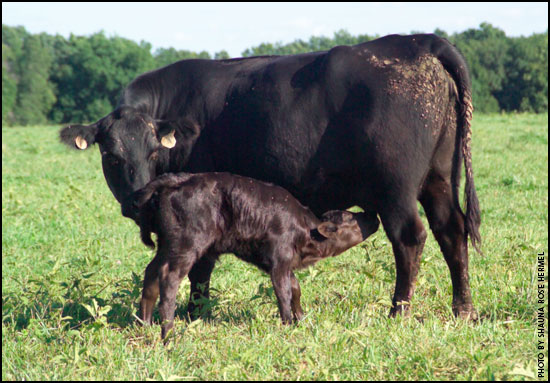Calf Scours Caused By
a Variety of Pathogens
One of the reasons why calf scours is such a challenging disease for producers is that it can be caused by a combination of two or more pathogens.
"There are four major pathogens that cause calf scours, and a host of minor ones," said Jerry Olson, senior veterinarian with Pfizer Animal Health. "In most cases, more than one of the causative agents is involved in clinical scours."
He added that diagnosis of the pathogen(s) involved in scours is challenging because the causative agent may no longer be present by the time the sample is collected and tested at a diagnostic laboratory, and some scours organisms also may be present in healthy calves. Postmortem exams also can be unreliable because dead animals often have intestinal bacterial overgrowth and/or postmortem tissue destruction.
While diagnosis based strictly on clinical signs is not possible, Olson noted some of the characteristics of major scours pathogens:
• Escherichia coli K99 should be suspected as a cause of scours in calves during the first week of life.
• Rotavirus serotype G6 and rotavirus serotype G10 also can surface in the first two weeks of life, but may be involved in animals a month of age or older. Infections involving either serotype of rotavirus often cause animals to have profuse watery diarrhea because the absorptive capacity of the gut is markedly reduced when the intestinal villi are blunted.
• Coronavirus usually causes more severe scours outbreak than rotavirus because it affects both the small and large intestine; whereas rotavirus affects primarily the small intestine. Coronavirus primarily affects calves from 1 to 3 weeks of age. However, like rotavirus, it may occur any time during the first month of a calf's life and beyond.
Both rotavirus and coronavirus are hardy organisms that can survive for months in moist, cool conditions.
Scours treatment is a frustrating proposition. "Infected animals very quickly have problems with nutrient malabsorption, excess secretion of fluids and intestinal inflammation," Olson said. "Once these factors start to snowball, their combined effect is difficult to overcome."
Olson advised that prevention is the most efficient approach to managing scours. Passive immunity created by vaccinating the dam and getting adequate quantities of high-quality colostrum from these vaccinated cows shortly after birth are very effective in preventing diarrhea caused by E. coli, rotavirus and coronavirus.
Olson said that, ideally, for maximum protection of the calf, vaccination of the dam should take place far enough ahead of the "colostrum concentration" window that high levels of antibodies are present in the blood at its onset. This starts at about three weeks before calving and peaks during the last two weeks before calving. This means that cows need to receive a booster at least three weeks prior to the IgG concentrating period.
ScourGuard® 4KC is the only vaccine labeled for protection against rotavirus serotypes G6 and G10. ScourGuard 4KC also aids in preventing diarrhea caused by coronavirus, E. coli K99 and Clostridium perfringens Type C. Olson advised that first-calf heifers should receive a two-dose vaccination regimen, given approximately three weeks apart. The first dose should be administered in the seventh or eighth month of pregnancy, with the second dose given five to six weeks before calving. After that, an annual booster shot given five to six weeks before each subsequent calving is recommended.
Comment on this article.
[Click here to go to the top of the page.]






